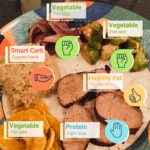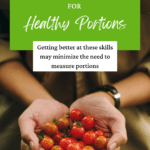Healthy Portions: Your hand size can tell you how much to eat
Should you take a cue from Aerosmith’s “The Hand That Feeds” and use your hands to gauge healthy portions?
Using hand portions to choose serving sizes is all the rage these days. But how does it work? Is it reliable? Is it effective at helping you lose/maintain weight? And is it worth the effort?
It looks like the idea behind using your hands to gauge portion sizes came from Dr. Kazzim Mawji in 1993 when he developed the technique to help people with diabetes come up with an easier way to measure the amount of food they were eating.
All Hands On Deck for Healthy Portions
The premise is that instead of relying on measuring cups and spoons or a scale, you can compare a portion of something to the size of your hand or thumb to know how much you should be adding to your plate.
Mind you, this method is meant to compare whole foods like proteins, vegetables, fruits, grains, and fats, not packaged products that likely already have serving sizes on their labels.
Portion control can be important if you’re trying to lose and/or maintain weight. Keep in mind that portions are different than serving sizes. Portions are the amount of something you eat while serving sizes are the actual amount of food in a serving. That is to say, you may have one or more portions per serving of a food on your plate.
There are benefits and drawbacks to using hand portions as a measuring system.
Advantages of Hand Portions
- Hand size is another tool that can be used to bring awareness to how much food you’re consuming.
- Portioning with hand size can help you focus on being more intentional about balancing your meals because they remind you to consider where your protein, carbs (especially vegetables), and fats are at each meal.
- Hand size portions are convenient. They can be used in place of calorie counting to make food tracking simple, and they’re readily available for use at home or on the go.
- Your hand size is perfectly tailored for how much food YOU should be eating.
- Knowing your portion sizes can keep you from overeating and gaining unwanted pounds.
- Even if your hand portion sizes are a little off, you’ll likely still be eating less just by paying attention to how much you’re consuming.
- They’re a great reminder that it’s not too difficult to get in a portion or two of vegetables and fruits, so it’s easier to add more of those nutrient powerhouses to your day as you work toward the recommended daily amounts.
Downsides of Hand Portions
- While they are more convenient to use, hand size portions may not give you an accurate reading on things like fat because you’ll never know how much a restaurant uses (and you can bet it’ll be a lot more than you’d use at home).
Their accuracy is also questionable because foods like protein have other macronutrients in them like fat that aren’t visible. Or if you’re eating out, you won’t have a clue how much butter or oil a restaurant uses even on vegetables or carbs like rice or other grains. This may seem negligible, but fat has more calories than the other macros, and if you’re eating a lot more of it than you realize you could sabotage your weight-loss/maintenance efforts.
- Using hand portions may help you control how much food you’re eating, but they’re not so great at helping you choose better options.
Sure, you can measure a thumb-sized portion of fat, but while a portion of olive oil is technically the same amount as a portion of an oil that’s high in saturated fat (like coconut or palm kernel oil), it’s not the same nutritionally. A portion of pork tenderloin doesn’t have the same nutrition as a hamburger patty. It’s kinda like being a vegetarian. You can be a “healthier” vegetarian if you eat lots of vegetables and high-quality proteins like beans. Or you can be a vegetarian who only eats a lot of pizza and French fries.
- It can still feel like a restrictive form of eating, and if you’ve spent years dieting and are ready to get off that bandwagon it may be time to do things that could be more helpful for long-term changes.
Why Use Hand Portions?
Only you can decide what you want to do with the knowledge you’re gaining about using hand portions. For instance, do you want to use them to help you lose or maintain weight (in which case you’ll probably need to figure out how many calories/portions a day you’ll need to do that)?
Your nutritional needs depend on your goals, but here are a few handy resources with portion size recommendations that may help you decide where to start.
- Healthy Eating Plate by Harvard University School of Public Health
- Learn more about food groups that work well with hand portioning with this downloadable Food Guide for Hand Measurement
If instead, you’re counting on healthy portions by using your hands to add more vegetables, fruits, lean protein, and healthy fats to your daily eating habits, you probably don’t need to stress about getting them exactly right.
A Great Starting Point
Insider Tip: I find hand portions to be a fantastic starting point, especially when it comes to eating during the holidays or whenever you’re presented with a lot of food choices.
For example, at Thanksgiving, my favorite holiday, I eyeball about one portion of protein, one portion of carbs, and several portions of vegetables and add them to my plate. Because I know that I can, and will, go back for more. And then I’ll do the same thing again. This helps me slow down and pay more attention to my hunger cues, without ever feeling deprived. It also leaves me lots of delectable leftovers, and I no longer feel sick to my stomach after heavier meals.
Outside of holiday meals, I tend to use hand portions more to make sure I’m eating a minimum of one portion of protein, a vegetable or two, and a healthy fat at most meals, and not so much for weight loss/maintenance.
Over the years I’ve found that a balanced diet, along with some basic mindful eating techniques, is just as or more important than portion sizes. But the two used in conjunction with each other can help you reach many weight (or other) goals you might be working on.
My Test Kitchen: A Hands on Experiment with Healthy Portions
I’ve been known to add a little too much olive oil to my veggies. Or butter on my organic sprouted whole wheat sourdough for breakfast. And I’m great at misjudging a portion of protein. To be honest, I’ve never compared using hand portions with actually measuring foods. So, I thought it might be a great time to experiment.
Here’s what happened. (To be fair, I have pretty small hands, so your portions might look bigger.)
This is the recipe I used (which I cut in half): Ancho Chile Pork Tenderloin With Brussels Sprouts and Squash

The macro breakdown of my entire plate as it converts to hand portions.
Measuring food with hands started with, how much protein
A portion of protein = 1 palm
When I took that same palm of protein in my hand and put it on the scale, it registered at 3.0 ounces.

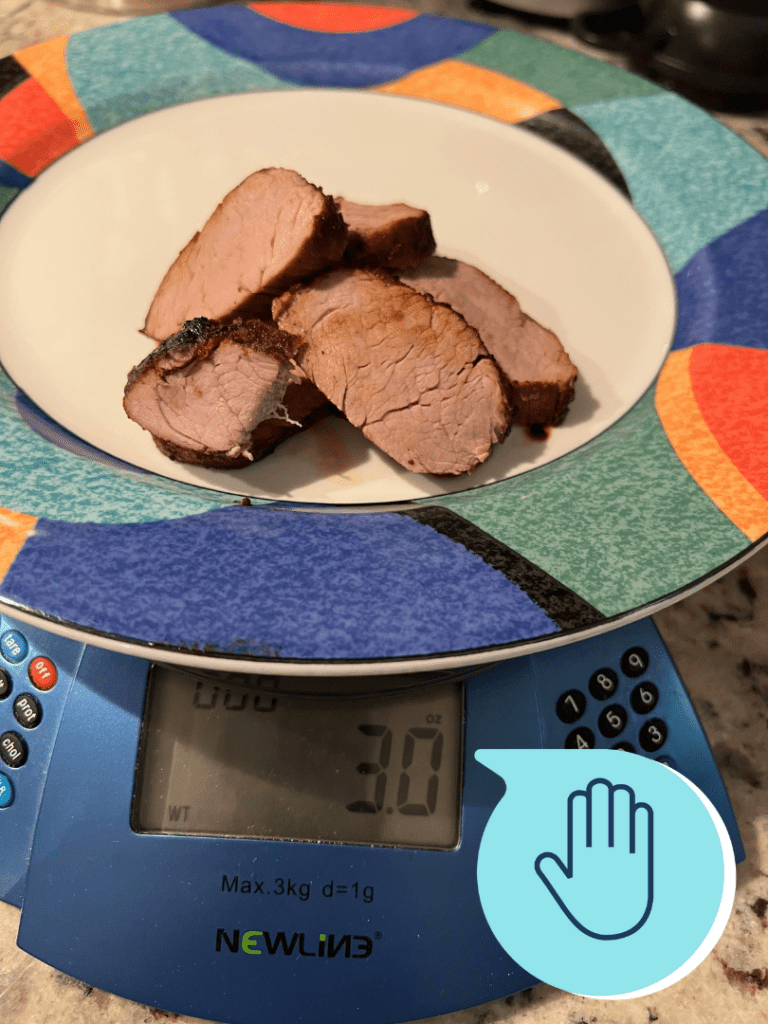
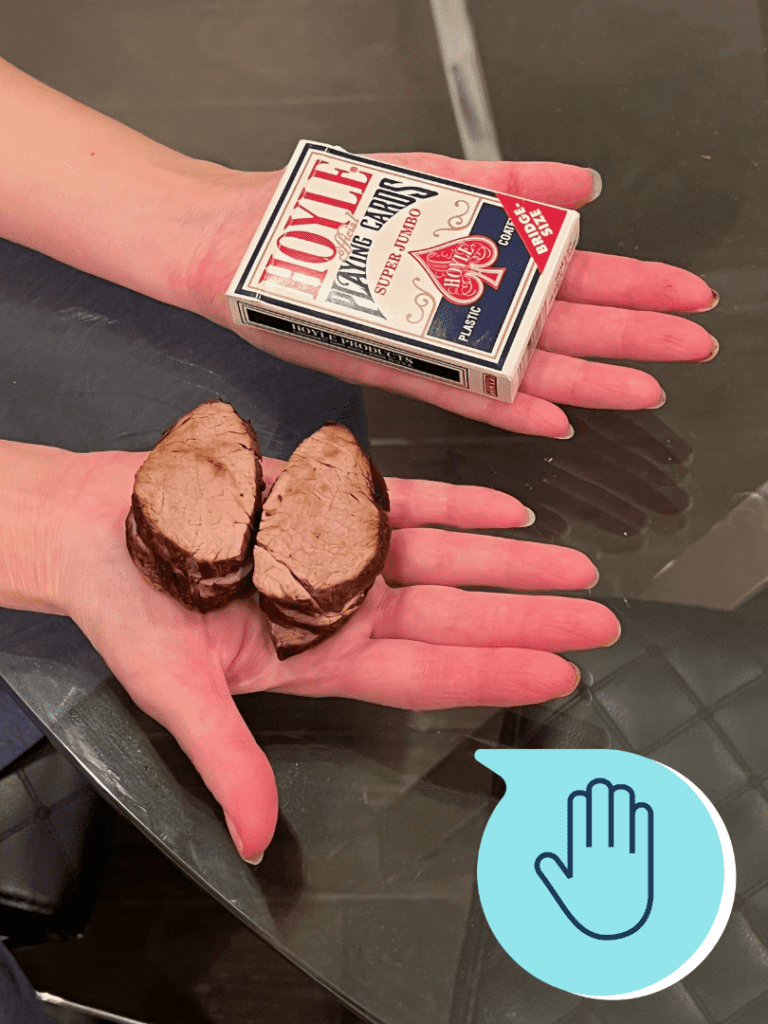
You can also see how the same portion of protein in my palm compares to a deck of cards (often used as a reference), which is a good comparison because the deck shows the thickness in addition to the palm size.
How many portions of vegetables did I eat?
A portion of vegetables = 1 fist.
When I took that same fist of Brussels Sprouts and added it to a measuring cup, it ended up fitting into ½ cup.

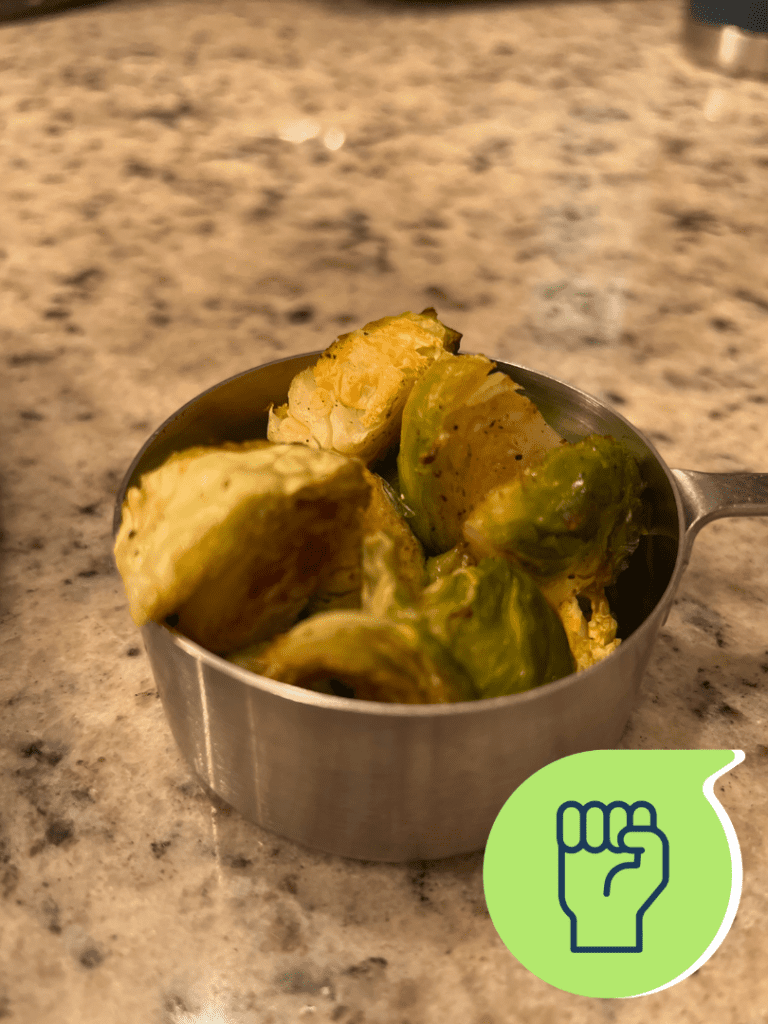
Again, a portion of vegetables = 1 fist.
When I took that same fist of red onions and added it to a measuring cup, it fit into ½ cup.
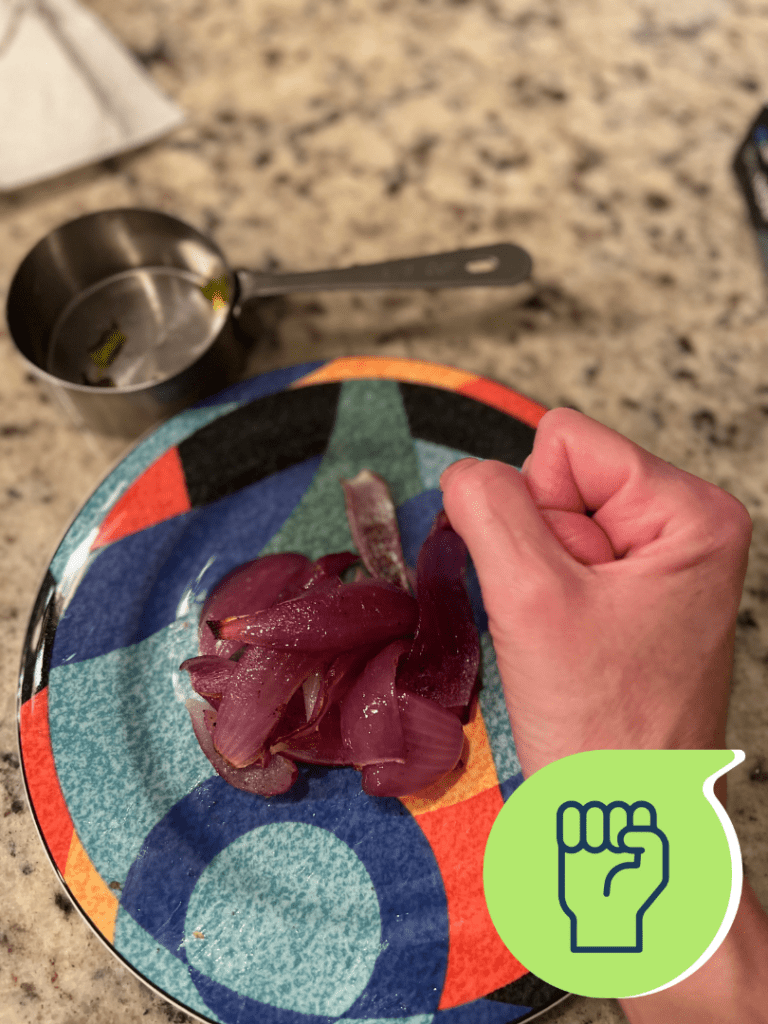
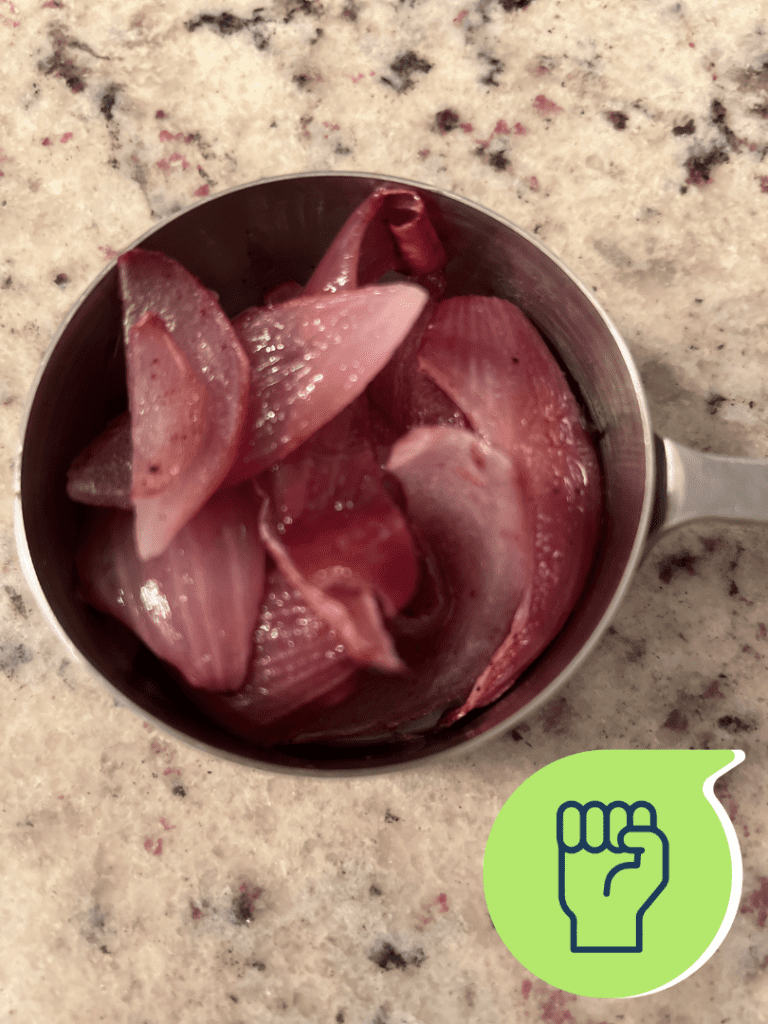
I decided to eyeball a fist size of Delicata squash instead of using my fist to see what I thought a portion might look like based on what I thought my fist size was.
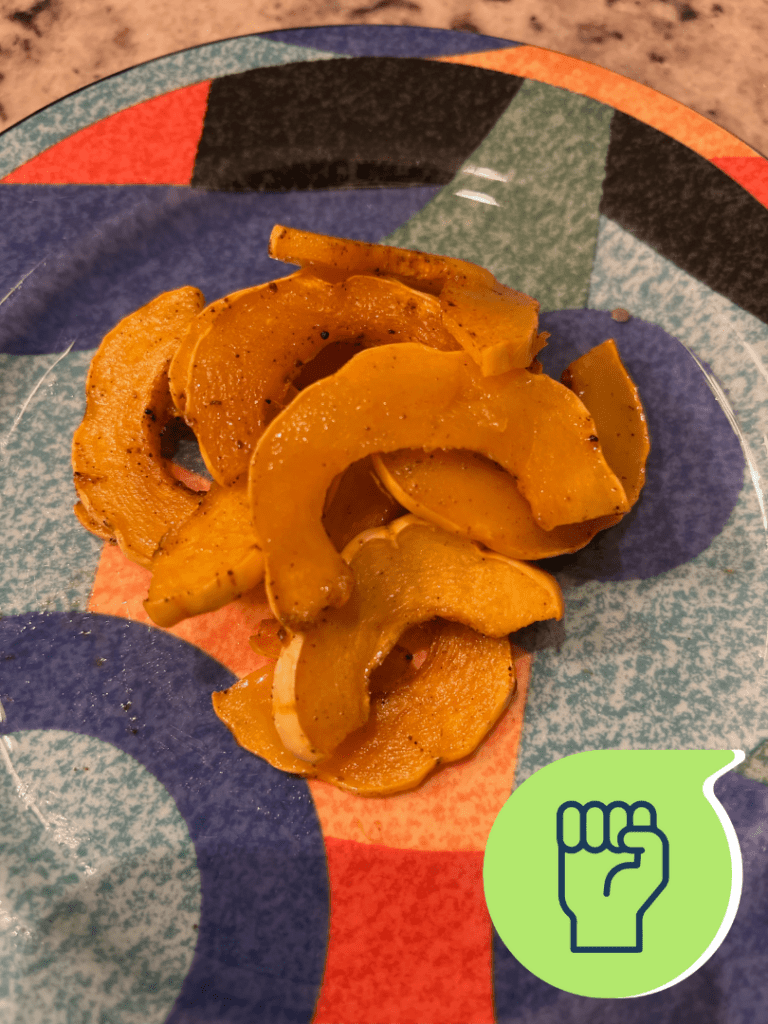
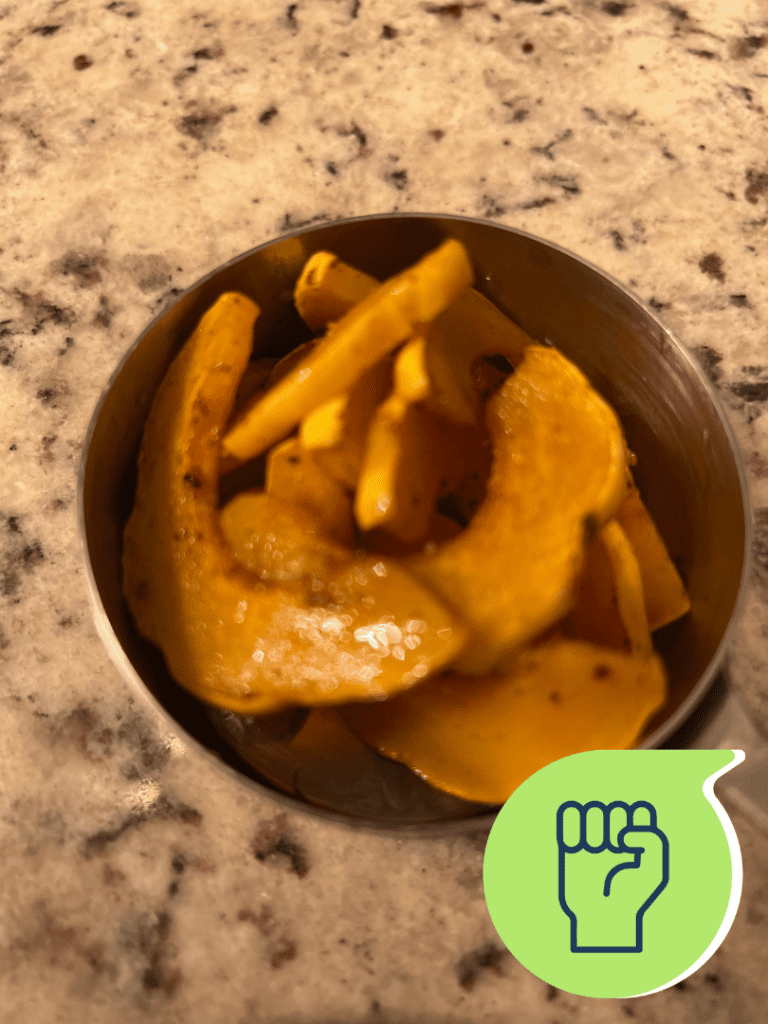
When added to a measuring cup, that fist size of Delicata squash came in around ½ cup.
My example of carbohydrate food for this meal
A portion of carbs = 1 cupped hand.
When I put the cupped portion of quinoa into a measuring cup, it equaled roughly ½ cup.

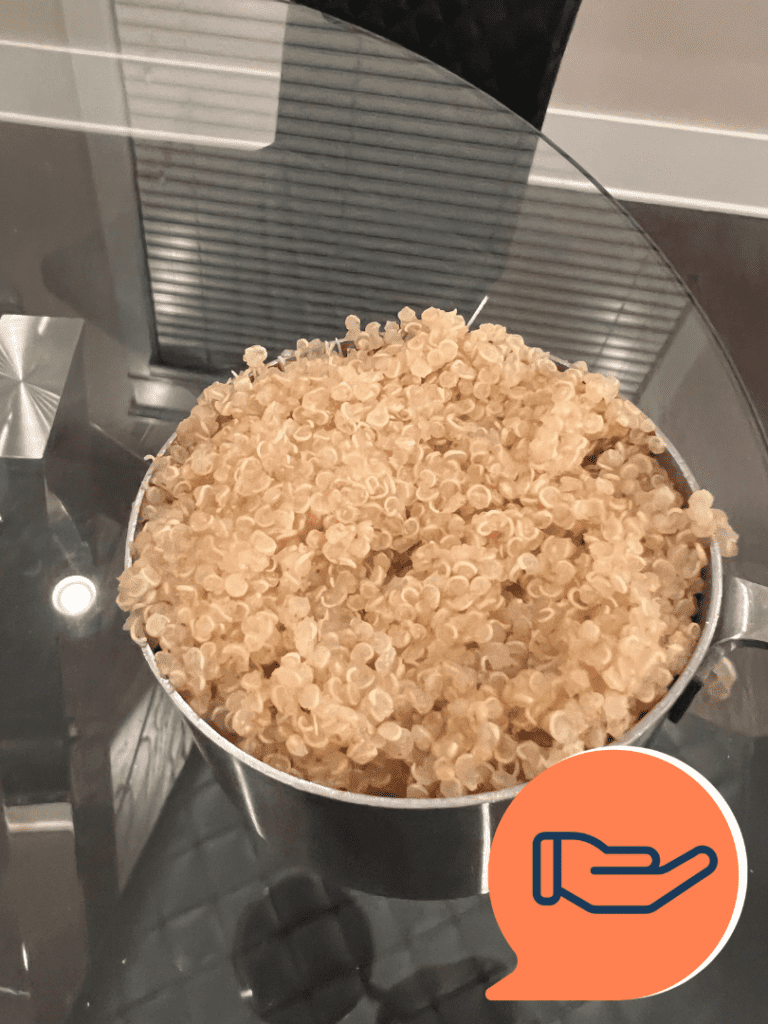
Looking at the fat portion of my meal
Here, I’ve taken a teaspoon of the sour cream sauce and compared it to my thumb so you could see it’s roughly equal to 1 thumb.
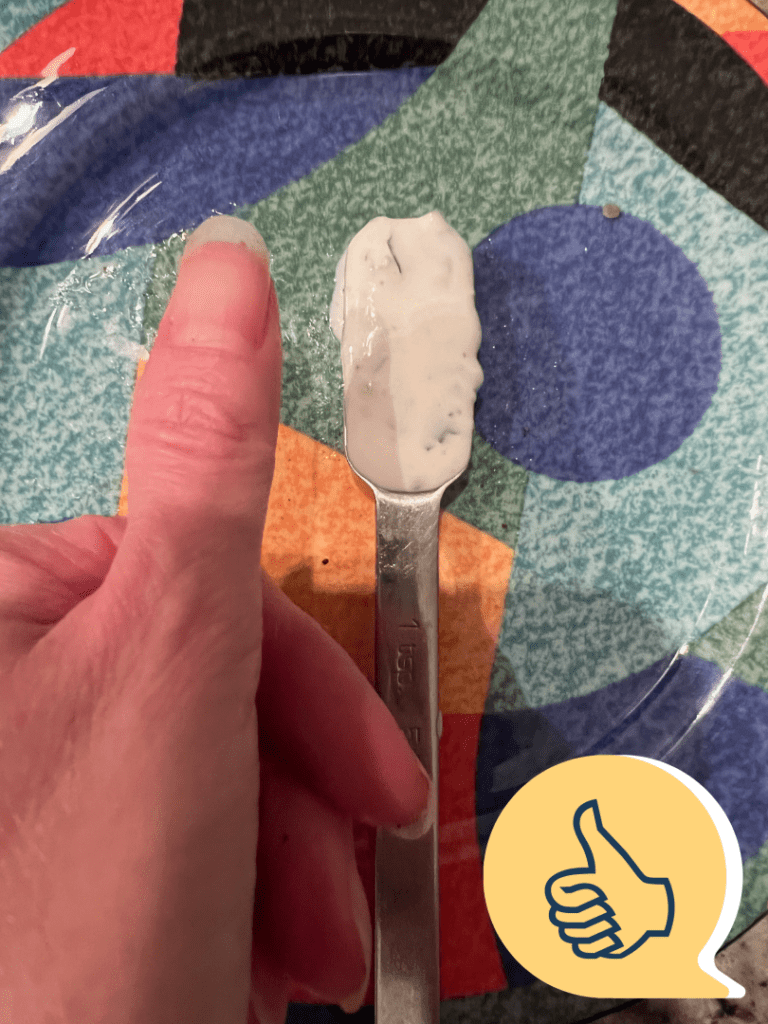
How hand size measures came together on my plate
This is a look at my entire plate, and it’s meant to give you an idea of how the portions came together based on my hand size and the recipe I used.

My plate added up to one serving of protein, three vegetables, one whole grain/ carb, and one fat. Keep in mind that I don’t use hand portions all the time, and that I’m looking to maintain weight.
(Not pictured – 2 teaspoons of canola oil to roast all the veggies and pork)
These are MY portion sizes (and, again, my hands are pretty small). Your meal might look entirely different based on your hand size and what goals you have, which is why it might be fun to test this out for yourself. I can look at my macros and my hand can represent a portion, but keep in mind that hand portions will never be perfect. You often won’t be able to capture it all. But it does create awareness around what and how much you’re eating, which is the ultimate goal anyway.
Years ago, I probably would have eaten everything on the plate (and gone back for more) because it was there, it tasted good, and I would have eaten too fast to recognize any fullness cues.
But because I’ve spent years learning and practicing habits like slowing down, eating to 80 percent full, and being aware of my hunger signals, I’m more skilled at recognizing when I’ve had enough and I ended up eating about three-quarters of what was on the plate. Which leads me to the basics
Build the Basics First
Focus first on doing things like striving to eat balanced meals made with minimally processed foods more often. Add quality, lean protein to meals when possible. Add vegetables and fruits every day. Practice eating slowly, mindfully, and to 80 percent full. These are the building blocks of healthier eating habits.
Getting better at these skills may minimize the need to measure portions. For one thing, they’ll fill you up faster, keep you feeling fuller longer, and automatically quell the desire to overeat. For another, they can be practiced anywhere, anytime.
And, finally, they make sure you’re getting vital nutrients to keep your body functioning at its best, which leads to things like stable energy levels and possibly less risk of disease.
Are Hand Portions Reliable?
Some studies claim hand portions are unreliable measurements.
“In conclusion, portion size estimations for amorphous foods, using hand or household measures, should be interpreted with caution due to the considerable error associated with these techniques for these food types.”
Others say they’re just as accurate as measuring.
“Our internal calculations show hand portions are about 95 percent as accurate as carefully weighing, measuring, and tracking your food. With substantially less effort and time involved.”
Get Your Hands Dirty
So, are hand portions reliable? They are if they work for you and whatever you’re trying to accomplish. Experiment for yourself. Get curious and take some time to compare your hand portion size to an actual size, as I did in the example above. Use measuring cups, teaspoons and tablespoons, and a scale.
Once you’ve done this a few times, see if it gets a little easier to estimate food portions using only your hand size. At the very least, you may shave off a few calories at each meal.
By now you might be beginning to see that hand portions may be effective in helping you figure out how much of a food you’re consuming, but alone they may not be the answer to weight loss or maintenance or overall healthier eating habits. A combination of using hand portions and practicing basic skills as often as possible may be a better use of time.
Despite some drawbacks, using hand portions will likely reduce your calorie intake to some extent. And if that’s your goal, give it a try. If overall healthier eating habits are what you’re aiming for, consider building your practices around adding vegetables, lean protein, mindful eating, and other techniques first. Then decide if using hand portions fits your lifestyle and other goals. You’re not failing at anything here. You’re simply gathering information about what works for you and what doesn’t.
Because of the possible inaccuracy of hand portions, and the tediousness of weighing and measuring every food you eat, focusing more on practicing skills like eating slowly, paying attention to how you feel while you’re eating, and learning what 80% full feels like could be more useful skills to practice. Think of all of this as an experiment to see what works best for you.
Don’t let portion control get out of hand
Oh, and while you’re at it… make sure you’re practicing working those self-compassion muscles too. They’re the ones that can help you go easy on yourself while you’re working on your new skills.
Remember that food is also meant to bring joy and allow yourself space to appreciate it.
Perfection rejectionist Lisa Kiersky Schreiber is a nutrition and lifestyle coach who helps clients take a holistic and realistic approach to wellness. Lisa got off the diet carousel and can help you do the same.
Find other articles written by Lisa on her coach profile. Her philosophy will help you simplify your nutrition lifestyle so you can learn to trust yourself implicitly around food.

